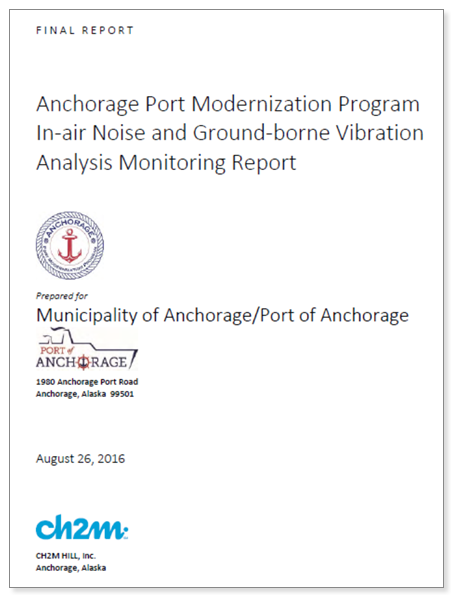Executive Summary
Aging infrastructure at the Port of Anchorage (POA) has far exceeded its economic and design life. Some of the oldest parts of the current infrastructure date back to the early 1960s. The POA is planning to undertake a reconstruction project—the Anchorage Port Modernization Program (APMP)—to improve and update these facilities. The APMP is planned for construction between 2017 and 2022 or later, dependent on available funding.
In advance of the APMP, the POA conducted a smaller‐scale effort during spring 2016, known as the Test Pile Program (TPP). The TPP consisted of installing 10, 48‐inch steel pipe indicator test piles adjacent to existing POA facilities. The primary purpose was to evaluate the performance of the pile installation equipment and methods under conditions similar to what will be used for production pile installation during the APMP. The information obtained during the TPP will be used to help inform, design, and implement the APMP.
The TPP was multifaceted, and a number of investigations and data sets were collected as the piles were installed. One of the efforts entailed an in‐air noise and ground‐borne vibration technical analysis to assess the potential impacts from the future construction of the APMP. The goal of this analysis is to evaluate how construction noise and ground‐borne vibration during the APMP might affect residences close to the POA as well as workers within the POA boundary. This report summarizes the in‐air noise and ground‐borne vibration analysis conducted during the TPP. In general, results of the in‐air noise and ground‐borne vibration monitoring are summarized as follows:
In‐air noise monitoring synopsis (residential areas): Monitored noise levels from pile driving did not exceed the Municipality of Anchorage (MOA) code limit of 80 A‐weighted decibels (dBA) Leq (equivalent continuous noise level, hourly). According to the long‐term monitoring effort, sound levels in the Government Hill neighborhood during pile‐driving activities ranged from 56 to 73 dBA Leq, while sound levels in the Cherry Hill neighborhood ranged from 54 to 78 dBA Leq. The loudest monitored pile driver sound levels were generally associated with the hydraulic impact pile driver followed by the diesel impact pile driver. Vibratory pile driver sound levels were measurable, but were lower than impact pile driver sound levels.
In‐air noise monitoring synopsis (POA tenant locations): Monitored pile‐driving noise levels were below the Occupational Safety & Health Administration maximum allowable impact levels, but fall within ranges for adverse occupational exposures during the course of an 8‐hour workday. All personnel required to work outside at the shoreline or within 150 feet of pile‐driving operations are recommended to wear hearing protection. Common types of hearing protection include ear plugs (disposable or reusable), semi‐insert ear plugs, and ear muffs. Noise levels collected inside facilities near the piledriving test locations do not indicate any exposures of concern.
Ground‐borne vibration monitoring synopsis: Monitored vibration levels attenuated quickly with distance from the piles driven. As a result, ground‐borne vibration from pile‐driving activity was not perceptible or of a level that could be readily identified over baseline ground‐borne vibration levels in the neighborhoods. The phenomenon experienced by some residents in the Government Hill neighborhood is most likely a result of low‐frequency noise associated with impact pile driving rather than ground‐borne vibration.
 View Full Report – pdf
View Full Report – pdf


